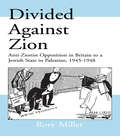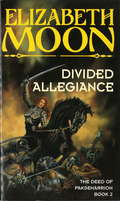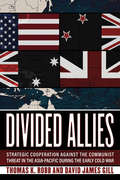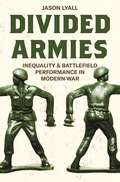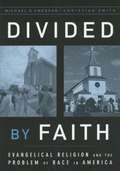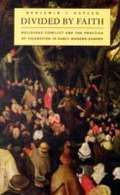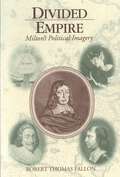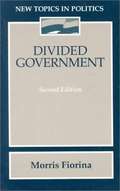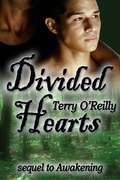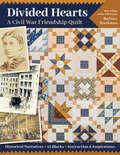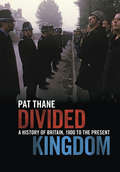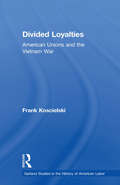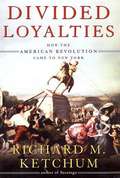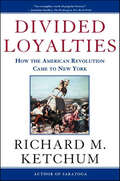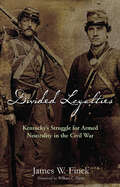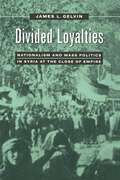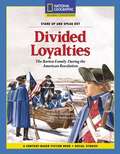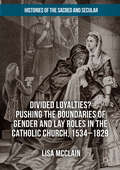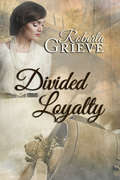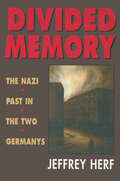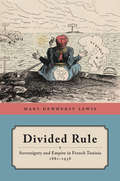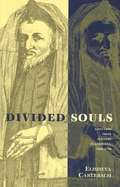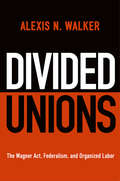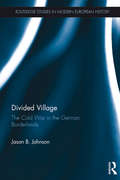- Table View
- List View
Divided Against Zion: Anti-Zionist Opposition to the Creation of a Jewish State in Palestine, 1945-1948 (Israeli History, Politics and Society #Vol. 11)
by Rory MillerUsing primary sources, this study of the relationship between three anti-Zionist bodies in Britain in the years that directly preceded the founding of the State of Israel also analyzes the Zionist attitude to the Jewish Fellowship, the Arab Office and the Committee for Arab Affairs.
Divided Allegiance: Book 2: Deed of Paksenarrion Series (Deed of Paksenarrion #2)
by Elizabeth MoonOnce a sheepfarmer's daughter, now a seasoned veteran, Paksenarrion has proved herself a formidable fighter. Years with Duke Phelan's company have taught her weaponry, discipline, and how to react as part of a military unit. Now, though, Paks feels spurred to a solitary destiny. Against the odds she is accepted as a paladin-candidate by the Fellowship of Gird. Years of study will follow, for a paladin must be versed in diplomacy and magic as well as the fighting arts. But, before she is fully trained, Paks is called to her first mission: to seek out the fabled stronghold of Luap. The way is long, the dangers many - and no one knows whether she will find glory or ruin.
Divided Allies: Strategic Cooperation against the Communist Threat in the Asia-Pacific during the Early Cold War
by David James Gill Thomas K. RobbBy directly challenging existing accounts of post-World War II relations among the United States of America, the United Kingdom, Australia, and New Zealand, Divided Allies is a significant contribution to transnational and diplomatic history. At its heart, Divided Allies examines why strategic cooperation among these closely allied Western powers in the Asia-Pacific region was limited during the early Cold War. Thomas K. Robb and David James Gill probe the difficulties of security cooperation as the leadership of these four states balanced intramural competition with the need to develop a common strategy against the Soviet Union and the new communist power, the People's Republic of China.Robb and Gill expose contention and disorganization among non-communist allies in the early phase of containment strategy in Asia-Pacific. In particular, the authors note the significance of economic, racial, and cultural elements to planning for regional security and they highlight how these domestic matters resulted in international disorganization. Divided Allies shows that, amidst these contentious relations, the antipodean powers Australia and New Zealand occupied an important role in the region and successfully utilized quadrilateral diplomacy to advance their own national interests, such as the crafting of the 1951 ANZUS collective security treaty.As fractious as were allied relations in the early days of NATO, Robb and Gill demonstrate that the post-World War II Asia-Pacific was as contentious, and that Britain and the commonwealth nations were necessary partners in the development of early global Cold War strategy.
Divided Armies: Inequality and Battlefield Performance in Modern War (Princeton Studies in International History and Politics #166)
by Jason LyallHow do armies fight and what makes them victorious on the modern battlefield? In Divided Armies, Jason Lyall challenges long-standing answers to this classic question by linking the fate of armies to their levels of inequality. Introducing the concept of military inequality, Lyall demonstrates how a state's prewar choices about the citizenship status of ethnic groups within its population determine subsequent battlefield performance. Treating certain ethnic groups as second-class citizens, either by subjecting them to state-sanctioned discrimination or, worse, violence, undermines interethnic trust, fuels grievances, and leads victimized soldiers to subvert military authorities once war begins. The higher an army's inequality, Lyall finds, the greater its rates of desertion, side-switching, casualties, and use of coercion to force soldiers to fight.In a sweeping historical investigation, Lyall draws on Project Mars, a new dataset of 250 conventional wars fought since 1800, to test this argument. Project Mars breaks with prior efforts by including overlooked non-Western wars while cataloguing new patterns of inequality and wartime conduct across hundreds of belligerents. Combining historical comparisons and statistical analysis, Lyall also marshals evidence from nine wars, ranging from the Eastern Fronts of World Wars I and II to less familiar wars in Africa and Central Asia, to illustrate inequality's effects.Sounding the alarm on the dangers of inequality for battlefield performance, Divided Armies offers important lessons about warfare over the past two centuries—and for wars still to come.
Divided By Faith: Evangelical Religion And The Problem Of Race In America
by Michael O. Emerson Christian SmithThrough a nationwide telephone survey of 2,000 people and an additional 200 face-to-face interviews, Michael O. Emerson and Christian Smith probed the grassroots of white evangelical America. They found that despite recent efforts by the movement's leaders to address the problem of racial discrimination, evangelicals themselves seem to be preserving America's racial chasm. In fact, most white evangelicals see no systematic discrimination against blacks. But the authors contend that it is not active racism that prevents evangelicals from recognizing ongoing problems in American society. Instead, it is the evangelical movement's emphasis on individualism, free will, and personal relationships that makes invisible the pervasive injustice that perpetuates racial inequality. Most racial problems, the subjects told the authors, can be solved by the repentance and conversion of the sinful individuals at fault. Combining a substantial body of evidence with sophisticated analysis and interpretation, the authors throw sharp light on the oldest American dilemma. In the end, they conclude that despite the best intentions of evangelical leaders and some positive trends, real racial reconciliation remains far over the horizon.
Divided By Faith: Religious Conflict and the Practice of Toleration in Early Modern Europe
by Benjamin J. KaplanAs religious violence flares around the world, we are confronted with an acute dilemma: Can people coexist in peace when their basic beliefs are irreconcilable? Benjamin Kaplan responds by taking us back to early modern Europe, when the issue of religious toleration was no less pressing than it is today. Divided by Faith begins in the wake of the Protestant Reformation, when the unity of western Christendom was shattered, and takes us on a panoramic tour of Europe's religious landscape--and its deep fault lines--over the next three centuries. Kaplan's grand canvas reveals the patterns of conflict and toleration among Christians, Jews, and Muslims across the continent, from the British Isles to Poland. It lays bare the complex realities of day-to-day interactions and calls into question the received wisdom that toleration underwent an evolutionary rise as Europe grew more "enlightened. " We are given vivid examples of the improvised arrangements that made peaceful coexistence possible, and shown how common folk contributed to toleration as significantly as did intellectuals and rulers. Bloodshed was prevented not by the high ideals of tolerance and individual rights upheld today, but by the pragmatism, charity, and social ties that continued to bind people divided by faith. Divided by Faith is both history from the bottom up and a much-needed challenge to our belief in the triumph of reason over faith. This compelling story reveals that toleration has taken many guises in the past and suggests that it may well do the same in the future.
Divided Empire: Milton's Political Imagery
by Robert Thomas FallonIn Divided Empire, Robert T. Fallon examines the influence of John Milton's political experience on his great poems: Paradise Lost, Paradise Regained, and Samson Agonistes. This study is a natural sequel to Fallon's previous book, Milton in Government, which examined Milton's decade of service as Secretary for Foreign Languages to the English Republic.Milton's works are crowded with political figures—kings, counselors, senators, soldiers, and envoys—all engaged in a comparable variety of public acts—debate, decree, diplomacy, and warfare—in a manner similar to those who exercised power on the world stage during his time in public office. Traditionally, scholars have cited this imagery for two purposes: first, to support studies of the poet's political allegiances as reflected in his prose and his life; and, second, to demonstrate that his works are sympathetic to certain ideological positions popular in present times.Fallon argues that Paradise Lost is not a political testament, however, and to read its lines as a critique of allegiances and ideologies outside the work is limit the range and scope of critical inquiry and to miss the larger purpose of the political imagery within the poem. That imagery, the author proposes, like that of all Milton's later works, serves to illuminate the spiritual message, a vision of the human soul caught up in the struggle between vast metaphysical forces of good and evil. Fallon seeks to enlarge the range of critical inquiry by assessing the influence of personal and historical events upon art, asking, as he puts it, "not what the poetry says about the events, but what the events say about the poetry." Divided Empire probes, not Milton's judgment on his sources, but the use he made of them.
Divided Government
by Morris FiorinaDiscusses the issues of the three branches of the United States Government
Divided Hearts
by Terry O'ReillySequel to AwakeningRobert, handsome half-breed apprentice cooper, travels to the Ohio Country with Nathaniel Morgan. Robert has loved Nathaniel since being apprenticed to him many years before. Robert’s love is unreturned, as Nathaniel’s heart belongs to another who has been left behind.Robert is unwillingly sent as an interpreter with the British Army to inform the settlers and the Shawnee that King George will honor the Indians’ claim to the land. Captured by the Shawnee, Robert comes to be loved by an Indian brave. Robert returns his love but only up to a point, as he is still held captive by his love for another man.Can he let his love for Nathaniel go and give himself completely to Red Horse? Or will he forever live his life with a divided heart?
Divided Hearts: A Civil War Friendship Quilt
by Barbara BrackmanThe fascinating story of Civil War friendships across the Mason-Dixon line from the bestselling author and “renowned quilt historian” (Time).Create your own historically inspired friendship quilt with twelve popular blocks from the Civil War era. Each album block comes with design variations and an optional center flourish, plus setting instructions. Read compelling narratives of the women who found their hearts divided during the war, yet left a legacy of friendship quilts as proof of their bond.“Inspired by friendship quilts created between 1840 and 1861, Brackman focuses on women with ‘divided hearts,’ Northern women living in the South, and Southern women educated in the North, or with families divided by the Civil War . . . readers learn about twelve women’s lives that spanned the divide. Photographs and maps accompany the biographies. History comes alive through these women . . . You don’t have to be a quilt maker to enjoy reading the history and biographies of these amazing women.” —The Literate Quilter“The historical narratives about the women are so interesting . . . The quilts are beautiful and I love the idea of a friendship quilt . . . [an] amazing book.” —Crafty Moms Share
Divided Kingdom: A History of Britain, 1900 to the Present
by Pat ThaneHow has the UK evolved into the country it is today? This clear, comprehensive survey of its history since 1900 explores the political, economic, social and cultural changes which have divided the nation and held it together, and how these changes were experienced by individuals and communities. Pat Thane challenges conventional interpretations of Britain's past based on stark contrasts, like the dull, conservative 1950s versus the liberated 'swinging sixties', and explores the key themes of nationalisms, the rise and fall of the welfare state, economic success and failure, imperial decline, and the UK's relationship with Europe. Highlighting changing living standards and expectations and inequalities of class, income, wealth, race, gender, sexuality, religion and place, she reveals what has (and has not) changed in the UK since 1900, why, and how, helping the reader to understand how our contemporary society, including its divisions and inequalities, was formed.
Divided Loyalties
by Brooke JeffreyThe Liberal Party has governed Canada for much of the country's history. Yet over the past two decades, the 'natural governing party' has seen a decrease in traditional support, finding itself in opposition for nearly half of that time. In Divided Loyalties, Brooke Jeffrey draws on her own experience as a party insider and on interviews with more than sixty senior Liberals to follow the trajectory of the party from 1984 to the leadership of Stéphane Dion in 2008. Riven by internal strife, leadership disputes, and financial woes, the Liberal Party today faces unprecedented challenges that threaten its very future. Conventional wisdom attributes the origins of the disarray to personal conflict between Jean Chrétien and Paul Martin. However, Jeffrey argues that this divisiveness is actually the continuation of a dispute over Canadian federalism and national unity which began decades earlier between John Turner and Pierre Trudeau. This dispute, as evidenced by recent leadership crises, remains unresolved to this day. An insightful examination of the federal Liberal Party, Divided Loyalties sheds much-needed light on an increasingly fissured party.
Divided Loyalties: American Unions and the Vietnam War (Garland Studies in the History of American Labor)
by Frank KoscielskiThis book explores the international leadership of the AFL-CIO, the UAW and UAW Local 600, the world's largest union local, and reveals that overall, working-class response to the Vietnam War mirrored that of the American society as a whole.
Divided Loyalties: How the American Revolution Came to New York
by Richard M. KetchumHow residents of New York State vied against one another during the American Revolution.
Divided Loyalties: How the American Revolution Came to New York
by Richard M. KetchumBefore the Civil War splintered the young country, there was another conflict that divided friends and family--the Revolutionary WarPrior to the French and Indian War, the British government had taken little interest in their expanding American empire. Years of neglect had allowed America's fledgling democracy to gain power, but by 1760 America had become the biggest and fastest-growing part of the British economy, and the mother country required tribute. When the Revolution came to New York City, it tore apart a community that was already riven by deep-seated family, political, religious, and economic antagonisms. Focusing on a number of individuals, Divided Loyalties describes their response to increasingly drastic actions taken in London by a succession of the king's ministers, which finally forced people to take sides and decide whether they would continue their loyalty to Great Britain and the king, or cast their lot with the American insurgents.Using fascinating detail to draw us into history's narrative, Richard M. Ketchum explains why New Yorkers with similar life experiences--even members of the same family--chose different sides when the war erupted.
Divided Loyalties: Kentucky’s Struggle for Armed Neutrality in the Civil War
by James W. FinckOn May 16, 1861, the Kentucky state legislature passed an ordinance declaring its neutrality, which the state’s governor, Beriah Magoffin, confirmed four days later. Kentucky’s declaration and ultimate support for the Union stood at odds with the state’s social and cultural heritage. After all, Kentucky was a slave state and enjoyed deep and meaningful connections to the new Confederacy. Much of what has been written to explain this curious choice concludes Kentucky harbored strong Unionist feelings. James Finck’s freshly written and deeply researched Divided Loyalties: Kentucky’s Struggle for Armed Neutrality in the Civil War shatters this conclusion. An in-depth study of the twelve months that decided Kentucky’s fate (November 1860 – November 1861), Divided Loyalties persuasively argues that the Commonwealth did not support neutrality out of its deep Unionist’s sentiment. In fact, it was Kentucky’s equally divided loyalties that brought about its decision to remain neutral. Both Unionists and Secessionists would come to support neutrality at different times when they felt their side would lose. Along the way, Dr. Finck examines the roles of the state legislature, the governor, other leading Kentuckians, and average citizens to understand how Kentuckians felt about the prospects of war and secession, and how bloodshed could be avoided. The finely styled prose is built upon a foundation of primary sources including letters, journals, newspapers, government documents, and published reports. By focusing exclusively on one state, one issue, and one year, Divided Loyalties provides a level of detail that will deeply interest both Kentuckians and Civil War enthusiasts alike. Kentucky’s final decision was the result of intrigue and betrayal within the Commonwealth while armies gathered around its borders waiting for any opportunity to invade. And it was within this heated environment that Kentuckians made the most important decision in their history.
Divided Loyalties: Nationalism and Mass Politics in Syria at the Close of Empire
by James L. GelvinJames L. Gelvin brings a new and distinctive perspective to the perennially fascinating topic of nationalism in the Arab Middle East. Unlike previous historians who have focused on the activities and ideas of a small group of elites, Gelvin details the role played by non-elites in nationalist politics during the early part of the twentieth century. Drawing from previously untapped sources, he documents the appearance of a new form of political organization—the popular committee—that sprang up in cities and villages throughout greater Syria in the immediate aftermath of the First World War. These committees empowered a new type of nationalist leadership, made nationalist politics a mass phenomenon for the first time, and articulated a view of nation and nationalism that continues to inform the politics of the region today.Gelvin does more than recount an episode in the history of nationalism in the Arab Middle East. His examination of leaflets, graffiti, speeches, rumors, and editorials offers fresh insights into the symbolic construction of national communities. His analysis of ceremonies—national celebrations, demonstrations, theater—contributes to our understanding of the emergence of mass politics. By situating his study within a broader historical context, Gelvin has written a book that will be of interest to all who wish to understand nationalism in the region and beyond.
Divided Loyalties: The Barton Family During the American Revolution
by Gare Thompson Barbara KiwakIn 1774, a colonial family decides whether it should support the Patriot cause or the Loyalist cause. These opposing views threaten to tear the family apart. Students will learn about important events that shaped American history through the Stand Up and Speak Out series of historical fiction readers' theater. Readers follow the lives of children and their families as they struggle to make the right decisions during times of change. (Genre: Historical Fiction for Readers' Theater)
Divided Loyalties? Pushing the Boundaries of Gender and Lay Roles in the Catholic Church, 1534-1829 (Histories of the Sacred and Secular, 1700-2000)
by Lisa McClainThis book explores changing gender and religious roles for Catholic men and women in the British Isles from Henry VIII’s break with the Catholic Church in 1534 to full emancipation in 1829. Filled with richly detailed stories, such as the suppression of Mary Ward’s Institute of English Ladies, it explores how Catholics created and tested new understandings of women’s and men’s roles in family life, ritual, religious leadership, and vocation through engaging personal narratives, letters, trial records, and other rich primary sources. Using an intersectional approach, it crafts a compelling narrative of three centuries of religious and social experimentation, adaptation, and change as traditional religious and gender norms became flexible during a period of crisis. The conclusions shed new light on the Catholic Church’s long-term, ongoing process of balancing gendered and religious authority during this period while offering insights into the debates on those topics taking place worldwide today.
Divided Loyalty
by Roberta GrieveCelia has always wanted to work on the family farm but her father refuses to allow it, saying it is not woman’s work and she takes a job at the local printing works. When war comes and the farm hands join up, she hopes her father will relent. But it is too late as her boss has taken on sensitive work for the Ministry of Information and Celia has to stay on at her job having signed the Official Secrets Act. Romance blossoms when she meets her brother Edgar’s RAF friend, Matthew. But tensions arise when Edgar begins to have doubts about his role in the war. Celia quarrels with Matt when he confides his concerns about Edgar’s problems and their effect on morale. She loyally takes Edgar’s side but still hopes she and Matt can make up their quarrel. But before she can do so, he flies off on a mission and is shot down. Will they ever be able to resolve their differences and find happiness?
Divided Memory: The Nazi Past in the Two Germanys
by Jeffrey HerfA “valuable” study of how political narratives about the nation’s Nazi past differed in East and West Germany (The Wall Street Journal).A significant new look at the legacy of the Nazi regime, this book exposes the workings of past beliefs and political interests on how—and how differently—the two Germanys recalled the crimes of Nazism, from the anti-Nazi emigration of the 1930s through the establishment of a day of remembrance for the victims of National Socialism in 1996.Why, Jeffrey Herf asks, would German politicians raise the specter of the Holocaust at all, in view of the considerable support its authors and their agenda had found in Nazi Germany? Why did the public memory of Nazi anti-Jewish persecution and the Holocaust emerge, if selectively, in West Germany, while it was repressed and marginalized in “anti-fascist” East Germany? And how do the politics of left and right come into play in this divided memory? The answers reveal the surprising relationship between how the crimes of Nazism were publicly recalled and how East and West Germany separately evolved as a Communist dictatorship and a liberal democracy. This book, for the first time, points to the impact of the Cold War confrontation in both West and East Germany on the public memory of anti-Jewish persecution and the Holocaust.Konrad Adenauer, Theodor Heuss, Kurt Schumacher, Willy Brandt, Richard von Weizsacker, and Helmut Kohl in the West and Walter Ulbricht, Wilhelm Pieck, Otto Grotewohl, Paul Merker, and Erich Honecker in the East are among the many national figures whose private and public papers and statements Herf examines. His work makes the German memory of Nazism—suppressed on one hand and selective on the other, from Nuremberg to Bitburg—comprehensible within the historical context of the ideologies and experiences of pre-1945 German and European history as well as within the international context of shifting alliances from World War II to the Cold War. Drawing on West German and East German archives, this book is a significant contribution to the history of belief that shaped public memory of Germany’s recent past.“Groundbreaking . . . admirably subjects both East and West to equal scrutiny.” —Forward“[A] masterful book.” —German History
Divided Rule
by Mary Dewhurst LewisAfter invading Tunisia in 1881, the French installed a protectorate in which they shared power with the Tunisian ruling dynasty and, due to the dynasty's treaties with other European powers, with some of their imperial rivals. This "indirect" form of colonization was intended to prevent the violent clashes marking France's outright annexation of neighboring Algeria. But as Mary Dewhurst Lewis shows in Divided Rule, France's method of governance in Tunisia actually created a whole new set of conflicts. In one of the most dynamic crossroads of the Mediterranean world, residents of Tunisia-- whether Muslim, Jewish, or Christian--navigated through the competing power structures to further their civil rights and individual interests and often thwarted the aims of the French state in the process.Over time, these everyday challenges to colonial authority led France to institute reforms that slowly undermined Tunisian sovereignty and replaced it with a more heavy-handed form of rule--a move also intended to ward off France's European rivals, who still sought influence in Tunisia. In so doing, the French inadvertently encouraged a powerful backlash with major historical consequences, as Tunisians developed one of the earliest and most successful nationalist movements in the French empire. Based on archival research in four countries, Lewis uncovers important links between international power politics and everyday matters of rights, identity, and resistance to colonial authority, while re-interpreting the whole arc of French rule in Tunisia from the 1880s to the mid-20th century. Scholars, students, and anyone interested in the history of politics and rights in North Africa, or in the nature of imperialism more generally, will gain a deeper understanding of these issues from this sophisticated study of colonial Tunisia.
Divided Souls: Converts from Judaism in Germany, 1500-1750
by Elisheva CarlebachCarlebach (history, Queens College and CUNY) writes that while conversion usually summoned up a kind of transfiguration and rebirth into a superior religion, the meaning began eroding when speaking of 16th century German Jews. Christians increasingly saw Jewish converts as "`taufjuden,' baptized, but not truly converted," a sentiment derived from earlier centuries with the crusaders. Carlebach's close readings of writings by converts provide instruction in Christian self-definition and Jewish identity in German lands. Overwhelmingly, the Jewish side of these uneasy converts never atrophied, but instead had a positive effect on their new Christian identity. Such converts would become central in the formation of a Jewish image held by both Christians and Jews for years to come.
Divided Unions: The Wagner Act, Federalism, and Organized Labor (American Governance: Politics, Policy, and Public Law)
by Alexis N. WalkerA comparative history of public and private sector unions from the Wagner Act of 1935 until todayThe 2011 battle in Wisconsin over public sector employees' collective bargaining rights occasioned the largest protests in the state since the Vietnam War. Protestors occupied the state capitol building for days and staged massive rallies in downtown Madison, receiving international news coverage. Despite an unprecedented effort to oppose Governor Scott Walker's bill, Act 10 was signed into law on March 11, 2011, stripping public sector employees of many of their collective bargaining rights and hobbling government unions in Wisconsin. By situating the events of 2011 within the larger history of public sector unionism, Alexis N. Walker demonstrates how the passage of Act 10 in Wisconsin was not an exceptional moment, but rather the culmination of events that began over eighty years ago with the passage of the Wagner Act in 1935.Although explicitly about government unions, Walker's book argues that the fates of public and private sector unions are inextricably linked. She contends that the exclusion of public sector employees from the foundation of private sector labor law, the Wagner Act, firmly situated private sector law at the national level, while relegating public sector employees' efforts to gain collective bargaining rights to the state and local levels. She shows how private sector unions benefited tremendously from the national-level protections in the law while, in contrast, public sector employees' efforts progressed slowly, were limited to union-friendly states, and the collective bargaining rights that they finally did obtain were highly unequal and vulnerable to retrenchment. As a result, public and private sector unions peaked at different times, preventing a large, unified labor movement. The legacy of the Wagner Act, according to Walker, is that labor remains geographically concentrated, divided by sector, and hobbled in its efforts to represent working Americans politically in today's era of rising economic inequality.
Divided Village: The Cold War in the German Borderlands (Routledge Studies in Modern European History)
by Jason B. JohnsonIn 1983, then-US Vice President George H.W. Bush delivered a speech in London. He had just been in West Berlin and spoke about his first visit to the Berlin Wall. Bush then went on to describe another German wall he saw after Berlin: "if anything, that wall was an even greater obscenity than its eponym to the north." The story of that wall is a fascinating and valuable slice of the history of post-war Europe. That wall had gone up nearly two hundred miles southwest of Berlin at the edge of divided Germany, in the tiny, remote farming village of Mödlareuth. For nearly half the twentieth century, the Iron Curtain divided Mödlareuth in two. In this little valley surrounded by forests and fields, the villagers of Mödlareuth found themselves on the literal front-line of the Cold War. The East German state gradually militarized the border through the community while eastern villagers exhibited a range of responses to cope with their changing circumstances, reflective of the variable nature of the Cold War border through Germany: along the Iron Curtain, the size and isolation of the divided place influenced the local character of the division.
